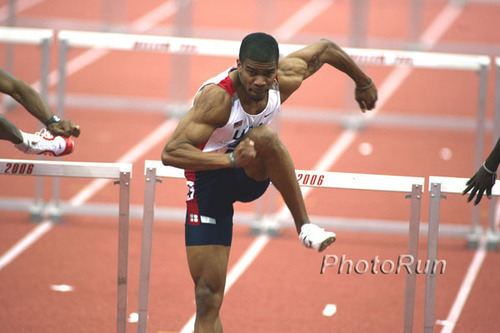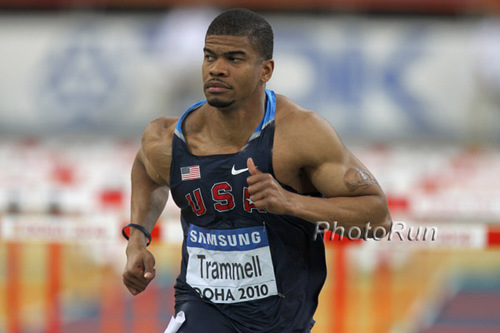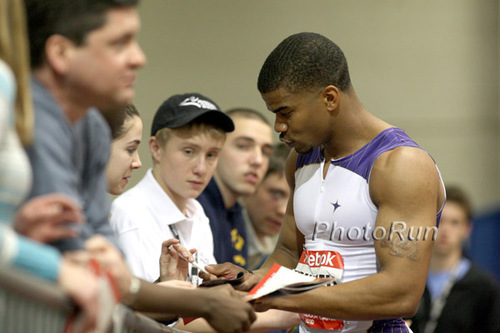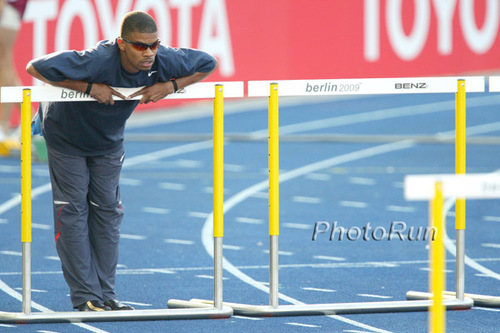How does a great athlete retire, and when? Does one go down fighting or, leave at the zenith of their career?

Terrence Trammell, Moscow 2006, photo by PhotoRun.net
Terrence Trammell has been part of the American hurdle scene and World scene for nearly a decade and one half.
In this piece, penned by Elliott Denman, Terrence Trammell speaks of his career as a tapestry of a period of his life: his joys, his frustrations, his wonderful letter from the great Harrison Dillard.
A wonderful tribute to such an amazing athlete.
We wish you best wishes on the next part of your journey, Terrence!
Terrence Trammell, US Olympic Trials 2008, photo by PhotoRun.net
TERRENCE TRAMMELL Has retired
By ELLIOTT DENMAN
UPDATED FEBRUARY 10, TO PROPERLY SPELL TERRENCE TRAMMELL’S NAME. THANKS TO JILL M. GEER AND AMBER BROOKS.
For over a decade and a half, Terrence Trammell stared down at those ten 42-inch
barriers challenging him directly ahead.
Almost always, they proved to be his friends, the obstacles he mastered en route
to national and global recognition as one of the finest 110-meter high hurdlers his sport has ever seen.
But, just as surely, there were other times they proved to be the dreaded enemies, the
only bar from his mounting the highest places on the most important podiums of the planet.
Terrence Trammell, photo by PhotoRun.net
“If you ran a great race, they were always your best friends,” Trammell said the other day, looking back on a brilliant career he has now announced has reached its finish line.
“But there were times, too, when they were not that friendly.”
He can recite the list of scars, nicks and bruises accumulated over the years, that
meant the difference between glory and dismay, medals or miseries, that forever tested his heart, soul and willingness to take on this essential test of mind and body, again and again and again.
Still, there comes a time to say goodbye to competi
tion at the highest of levels, and that time finally came for Trammell.
“Look, I have absolutely no regrets about announcing my retirement,” the 6-foot-2,
185-pound three-time Olympian said in a phone interview.
“And an awful lot to be proud of. I won two Olympic medals (both silvers.) I won three medals at the Outdoor Worlds (all silvers, too.) I won (golds at) two Indoor Worlds. I made an American national team, one kind or another, for a dozen years. I traveled the world. I brought honors to my country.”
There was never time for bragging about any of that. Terrence Trammell was a gentleman throughout, good times or not-so-good.
Terrence Trammell, World Champs 2009, photo by PhotoRun.net
There were the two Olympic silvers, back of Anier Garcia of Cuba at Sydney in 2000, and Liu Xiang of China at Athens in 2004, by a net of 43 100ths of a second.
But there was to be no third, the one he surely thought could have been a gold. He’d placed second in the 2008 Olympic Trials. He thought he was in superb shape as headed for Beijing.
But it all came unraveled one day at the Olympic training track.
“I’d had several injuries over the years but thought they were all behind me. I was really ready. I was ready to go. I knew I could run under the world record. Until I felt something in my left hamstring.”
It turned out to be a Grade 2 strain of the hamstring, stretching through to the attachment to his left knee.
“It could have been fixed by a simple adjustment,” he said.
Only problem was that personal coaches and medical aides were not allowed onto the
area of the training track. He had to rely on team staff not attuned to his personal situation.
“The best I could do was walk over to the fence and talk through it to Coach (Nat) Page that way. I had medical people there, too, who could have helped.”
But they were kept off limits and the injury worsened.
By the time he settled into the starting blocks for his first-round heat at famed Bird’s Nest Stadium, he knew it was over. He limped away and his third Olympic dream was over.
For Trammell, the issue became a call for increased athletes’ rights. He became a strident advocate, on both the national and international levels. And things soon happened.
Situations like his in 2008 are just unfortunate history.
He was still close to the top of his game the next three years, taking silvers in
the 2009 USA Outdoor Nationals and Berlin Worlds, and ran third in the 2012 Indoor Nationals, before a saddened fifth in his 2012 Olympic Trials heat.
With his seven USA hurdles crowns (five indoors, two outdoors), six NCAA gold medals,three Outdoor Worlds silvers, one World University Games title, and a personal best of 12.95 for the 110s that still ranks him equal 12th on the all-time list, and a 7.36 for the indoor 60s that puts him equal third on the all-time charts, his place in the history books is secure.
Close as he’d been to golds in the Olympics, he was even closer to golds in three Outdoor Worlds: Paris 2003, 8/100ths back of Allen Johnson; Osaka 2007, 4/100ths back of Liu Xiang; Berlin 2009, a single 100th back of Barbados’ Ryan Brathwaite.
For sure, he will be recognized right up there with fellow Americans Lee Calhoun and
Roger Kingdom (two Olympic golds apiece), Renaldo Nehemiah, Greg Foster, Allen Johnson. Willie Davenport, Hayes Jones, Harrison Dillard and Jack Davis as one of the finest timber-toppers (using the terminology of a bygone age) American track has ever seen.
For much of track history, Americans simply “owned” the high hurdles. Exhibit A – the six straight American gold medalists in the Olympic Games from 1896 to 1912. Exhibit B – the nine straight golds, 1932-1972. Exhibit C – three golds in the four Games between 1988-1996.
However, the 21st century has seen mixed fortunes for American high hurdlers. After the Olympic wins by Anier Garcia (2000), Liu Xiang (2004) and Dayron Robles of Cuba (2008), Aries Merritt and Jason Richardson put the USA back on top with their 1-2 slam at London in 2012. David Oliver followed by winning at the 2013 World Championships in Moscow.
But the rest of the world keeps on catching up – and surging ahead.
Track and Field News’ 2014 world rankings show zero Americans in the top five. On a list headed by France’s Pascal Martinot-Lagarde, David Oliver (6th), Ronnie Ash (7th), Ryan Wilson (9th) and Devon Allen (10th) are the top American placers.
Terrence Trammell, 2010, photo by PhotoRun.net
In retrospective, that puts Trammell’s illustrious career in an even more remarkable category.
None of it might have transpired if he’d made a different decision coming out of Atlanta’s Southwest DeKalb High School in June 1997.
“I was pretty good in football,” he reminds you, which was putting it mildly.
A sensational wide receiver, free safety and kick returner, he had scholarship offers from scores of major college teams around the nation. Nebraska, Michigan, Southern Cal, Texas, Miami, Clemson, Florida, Louisville and a whole lot more came courting.
The day after he returned a kickoff 99 yards in the state championship game saw the
lineup of football recruiters get even longer.
His decision turned out to be “none of the above.”
It was the University of South Carolina, where coach Curtis Frye convinced him his real future was in track and field, and where Frye lived up to all his promises.
The hurdles races and Curtis Frye – they have always been perfect together.
In a previous coaching stay at North Carolina, Frye had guided the career of Allen Johnson.
At South Carolina, he mentored Lashinda Demus, en route to her four National titles over the 400 hurdles, the 2011 World title, and 2012 Olympic silver; and Jason Richardson, to his 2011 World Outdoor gold and 2012 Olympic silver.
Soon enough, Frye and Trammell proved a winning combination in Columbia, S.C. It worked out splendidly as he sped to six NCAA golds, indoors, outdoors and relays, for the Gamecocks.
Good as he’s been over the hurdles, he’s been pretty darn good, too, in the races where no barriers were placed in his lanes. His flat-racing “legal” PRs are 10.04 and 20.74.
The 2000 NCAA Indoor Championships, for instance. He won both the 60-meter dash and the 60-meter hurdles.
The 2002 and 2003 Millrose Games, for instance. He won the Millrose hurdles in ’02 and ran second in the dash; then won the dash in ’03 and ran second in the hurdles.
The 2006 USA Indoor Nationals, for instance. He won the hurdles and ran second in the dash.
Relay-wise, he carried the baton on winning 4×100 teams at the ’99 NCAAs and World University Games.
He’s not really sure whether this kind of double duty was in his best long-term interest.
But he did have fun running them along the way.
It’s no wonder that Harrison Dillard always ranked high on Terrence Trammell’s list of track and field heroes. Four-plus decades before Trammell arrived on the national scene, Dillard was starring in both hurdles and sprints.
The remarkable Baldwin-Wallace (Ohio) College athlete took the gold in the 1948 London Olympic 100-meter dash (after crashing the hurdles in the Olympic Trials), then won in his “real event,” the 110 high hurdles at the 1952 Helsinki Games. To cap it all, he added golds in the 4×100 relay at each of those Games.
One of Trammell’s most cherished possessions these days is a letter from Dillard, cheering his feats and totally encouraging.
Terrence Trammell, photo by PhotoRun.net
While his own track career phases out, Trammell, 36, looks ahead to a world of
new opportunities.
“I’ve got a lot of things going,” he tells you.
There’s his Atlanta-based all-sports speed training enterprise.
There are the Mount Carmel Rams, the youth football players he coaches, and
teaches life-lessons, re-connecting to his former starring days on the gridiron.
There’s a steady stream of public speaking invitations.
There are continuing challenges as he stays busy in the Athletes Advisory Council
of USA Track and Field.
On the back burner while he does all this is his Track Star Apparel design and
production company.
As he hangs up his spikes, he never, ever lets the might-have-beens of all this
dominate his thought processes.
The medals he hoped to win but didn’t? The medals he did win when few others
expected him to? The big occasions? The big disappointments? The narrow misses?
“You can’t ever look back at it that way,” he say
s.
“A lot more important are the friends I’ve made, the experiences I’ve had, the
places I’ve been to, the things I’ve learned.
“I know guys who’ve won Super Bowl rings, who’ve made a lot of money in the NFL.
“Well, that’s the route they choose.
“I’ll take my two Olympic medals, and all I did in track, over that anytime.”
Terrence Trammell, 2009, photo by PhotoRun.net
Larry Eder has had a 52-year involvement in the sport of athletics. Larry has experienced the sport as an athlete, coach, magazine publisher, and now, journalist and blogger. His first article, on Don Bowden, America's first sub-4 minute miler, was published in RW in 1983. Larry has published several magazines on athletics, from American Athletics to the U.S. version of Spikes magazine. He currently manages the content and marketing development of the RunningNetwork, The Shoe Addicts, and RunBlogRun. Of RunBlogRun, his daily pilgrimage with the sport, Larry says: "I have to admit, I love traveling to far away meets, writing about the sport I love, and the athletes I respect, for my readers at runblogrun.com, the most of anything I have ever done, except, maybe running itself." Also does some updates for BBC Sports at key events, which he truly enjoys. Theme song: Greg Allman, " I'm no Angel."
View all posts


























